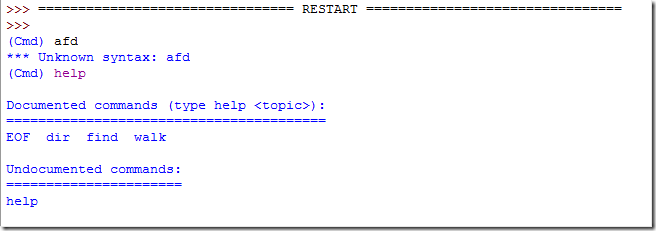再过两个CDays我们就完成了所有的功能了,不过是在CMD中运行的。
为了模块化我们的程序,我们先整理一下以前的程序。
# -*- coding: utf-8 -*- import os def cdWalker(cdrom,cdcfile): export = "" for root, dirs, files in os.walk(cdrom): export+="\n %s;%s;%s" % (root,dirs,files) open(cdcfile, 'w').write(export) if __name__ == '__main__': # this way the module can be CDROM = 'D:\\CDROM'
这个模块完成了CDROM的遍历,并存进了指定文件中。
虽然这个程序没有GUI,那么让我们给他设计一个CMD运行的界面吧。
根据上一次的日志,我们发现根据命令不同会有很多很多的分支,那么我们看一下书上给的例子pycdc-v0.4.py。
# -*- coding: utf-8 -*- '''pycdc-v0.4.py Lovely Python -2 PyDay ''' import sys, cmd class PyCDC(cmd.Cmd): def __init__(self): cmd.Cmd.__init__(self) # initialize the base class self.CDROM = 'D:\\CDROM' self.CDDIR = 'D:\\' def help_EOF(self): print "退出程序 Quits the program" def do_EOF(self, line): sys.exit() def help_walk(self): print "扫描光盘内容 walk cd and export into *.cdc" def do_walk(self, filename): if filename == "":filename = raw_input("输入cdc文件名:: ") print "扫描光盘内容保存到:'%s'" % filename def help_dir(self): print "指定保存/搜索目录" def do_dir(self, pathname): if pathname == "": pathname = raw_input("输入指定保存/搜索目录: ") print "指定保存/搜索目录:'%s' ;默认是:'%s'" % (pathname,self.CDDIR) def help_find(self): print "搜索关键词" def do_find(self, keyword): if keyword == "": keyword = raw_input("输入搜索关键字: ") print "搜索关键词:'%s'" % keyword if __name__ == '__main__': # this way the module can be cdc = PyCDC() # imported by other programs as well cdc.cmdloop()
根据书上所述,我们不知道上面的一些语法是什么,的确,我们确实不知道。
让我们运行一下.
提示输入.
输入非法字符有提示.
输入合法字符, 好吧,程序里没有,我承认我已经看晕了.
让我们看一下书,书上说是用的CMD模块, 查一下cmd是干嘛的.
根据作弊条PCS201
cmd模块为命令行接口cli提供了一个简单的框架.下面给出了一个例子.
# -*- coding: utf-8 -*- import cmd import string, sys class CLI(cmd.Cmd): def __init__(self): cmd.Cmd.__init__(self) self.prompt = '> ' # 定义命令行提示符 def do_hello(self, arg): # 定义hello命令所执行的操作 print "hello again", arg, "!" def help_hello(self): # 定义hello命令的帮助输出 print "syntax: hello [message]", print "-- prints a hello message" def do_quit(self, arg): # 定义quit命令所执行的操作 sys.exit(1) def help_quit(self): # 定义quit命令的帮助输出 print "syntax: quit", print "-- terminates the application" # 定义quit的快捷方式 do_q = do_quit # 创建CLI实例并运行 cli = CLI() cli.cmdloop()
根据这个例子中的注释,我们可以知道这个模块大部分的用法。作为CDays-2的要求,我们知道怎么用就可以了。
我们重新分析pycdc-v0.4.py
没有定义命令提示符
do_命令 —————— 是该命令执行的函数
help_命令 —————— 是该命令的帮助函数
cmdloop( ) 的意思是能自动返回cmd输入命令状态。
让我们加入自己编写的模块好了。
# -*- coding: utf-8 -*- '''pycdc-v0.5.py Lovely Python -2 PyDay ''' import sys, cmd from cdctools import * class PyCDC(cmd.Cmd): def __init__(self): cmd.Cmd.__init__(self) # initialize the base class self.CDROM = 'D:\\CDROM' self.CDDIR = 'D:\\' self.prompt="(PyCDC)>" self.intro = '''PyCDC 0.5 使用说明: dir 目录名 # 指定保存和搜索目录,默认是 "cdc" walk 文件名 # 指定光盘信息文件名,使用 "*.cdc" find 关键词 # 遍历搜索目录中所有.cdc文件,输出含有关键词的行 help # 查询 EOF # 退出系统,也可以使用Crtl+D(Unix)|Ctrl+Z(Dos/Windows) ''' def help_EOF(self): print "退出程序 Quits the program" def do_EOF(self, line): sys.exit() def help_walk(self): print "扫描光盘内容 walk cd and export into *.cdc" def do_walk(self, filename): if filename == "":filename = raw_input("输入cdc文件名:: ") print "扫描光盘内容保存到:'%s'" % filename cdWalker(self.CDROM,self.CDDIR+filename) def help_dir(self): print "指定保存/搜索目录" def do_dir(self, pathname): if pathname == "": pathname = raw_input("输入指定保存/搜索目录: ") self.CDDIR = pathname print "指定保存/搜索目录:'%s' ;默认是:'%s'" % (pathname,self.CDDIR) def help_find(self): print "搜索关键词" def do_find(self, keyword): if keyword == "": keyword = raw_input("输入搜索关键字: ") print "搜索关键词:'%s'" % keyword cdcGrep(self.CDDIR,keyword) if __name__ == '__main__': # this way the module can be cdc = PyCDC() # imported by other programs as well cdc.cmdloop()
到此为止,我们已经基本完成了CDC的除了查找外的所有功能了。
现在让我们解决查找问题。
根据当时我们保存的内容,我们将每个文件保存为一行,所以我们可以一行一行的寻找。
def cdcGrep(cdcpath,keyword): filelist = os.listdir(cdcpath) # 搜索目录中的文件 for cdc in filelist: # 循环文件列表 cdcfile = open(cdcpath+cdc) # 拼合文件路径,并打开文件 for line in cdcfile.readlines(): # 读取文件每一行,并循环 if keyword in line: # 判定是否有关键词在行中 print line # 打印输出
把这段程序放在cdctools.py 中就可以了。




